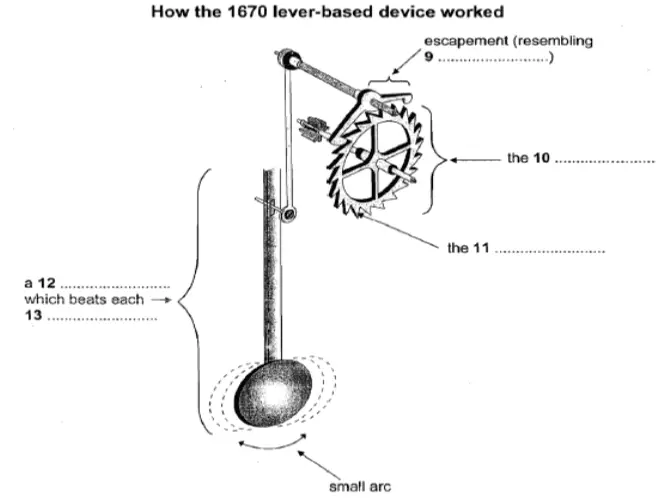The Blog post contains the following IELTS Reading Questions:
- IELTS Reading Locating Information Questions
- IELTS Reading Short Answer Questions
- IELTS Reading Diagram Labelling Questions
Unlock your full potential in the IELTS Reading section – Visit our IELTS Reading Practice Question Answer page now!
Recommended Questions:
Renewable Energy IELTS Reading Question with Answer

IELTS Reading Passage – A Chronicle of Timekeeping
Read the IELTS reading passage below and respond to the questions (1-13). Verify your responses with the A chronicle of timekeeping reading answers with explanations provided subsequently.
A Chronicle of Timekeeping
Before the Roman Empire even existed, at least 5,000 years ago, according to archaeological evidence, the Babylonians invented calendars to coordinate social activities, arrange the transportation of products, and, in particular, to control planting and harvesting. Their calendars were based on three natural cycles: the solar day, which corresponds to the alternation of periods of light and darkness as the earth rotates on its axis; the lunar month, which tracks the phases of the moon as it orbits the earth; and the solar year, which is determined by the varying seasons that coincide with our planet’s rotation around the sun.
The moon had a bigger social impact before the development of artificial light. And its growing and fading was more obvious to people who lived close to the equator than the change of the seasons. As a result, the moon cycle rather than the solar year had a greater impact on the calendars that were created in lower latitudes. The solar year, however, became more important in northern climates where seasonal agriculture was practised. The solar year served as the primary organising principle for the Roman Empire’s activity chart as it grew northward. Egyptians developed a municipal calendar with 12 months of 30 days and five extra days to resemble the solar year centuries before the Roman Empire. Decans, distinctive constellations of stars, appeared every ten days to indicate a ten-day period. 12 decans may be seen sweeping the heavens at the rising of the star Sirius immediately before daybreak, which took place around the crucial yearly flooding of the Nile. The Egyptians developed a system in which each interval of darkness (and later, each interval of daylight) was divided into a dozen equal pieces due to the cosmic significance they attached to the 12 decans. These intervals, which varied in length in accordance with the length of the days and nights as the seasons changed, came to be known as temporal hours. Only at the spring and fall equinoxes were the lengths of daylight and nighttime equal. Summer hours were long, winter hours were short. Temporal hours were used for more than 2,500 years after being initially accepted by the Greeks and later the Romans, who spread them throughout Europe.
Sundials, which tell the time by the length or direction of the sun’s shadow, were invented by inventors to keep track of the temporal hours throughout the day. The water clock, the sundial’s inverse, was made to count the hours of the night. One of the original water clocks consisted of a basin with a tiny hole towards the bottom through which water leaked. As the water level dropped below the hour lines etched on the inner surface, it indicated the passing hour. Although these gadgets worked well around the Mediterranean, it was difficult to rely on them in northern Europe’s overcast, frequently chilly weather. When the mechanical clock was invented, it was ideally suited to retaining equal hours even though it could be changed to preserve temporal ones. However, the issue of when to start counting arose with them, leading to the development of other systems in the early 14th century. Depending on the time of the count, different systems were used to divide the day into 24 equal parts: Italian time started at dusk, Babylonian time at dawn, astronomical time at noon, and the “big clock” time, which is used for some very large public clocks in Germany, at midnight. These eventually gave way to “little clock” or French hours, which divided the day into two 12-hour blocks beginning at midnight. In Bedfordshire, England, a weight-driven mechanical clock was constructed in 1283. Its escapement, which had been around for at least 1,300 years, was what made this new timepiece remarkable, not the descending weight that produced its driving force or the gear wheels that conveyed the power. The coiled spring, also known as a fusee, was created in the early 1400s and kept the gear wheels of a timekeeper turning steadily despite changes in the mainspring’s tension. A pendulum clock was invented in the 16th century, but it was ineffective since the pendulum swung in a wide arc. In order to solve this, an alternative to the original escapement was created in England in 1670. It was a lever-driven tool with the shape of an anchor for a ship and was known as the anchor escapement. This apparatus is rocked by a pendulum such that each escape wheel tooth is caught and then released, allowing the escape wheel to turn precisely. The anchor escapement allowed the pendulum to swing in a far smaller arc than the original design found in early pendulum clocks. Additionally, this innovation made it possible to utilise a long pendulum that could beat once per second, which encouraged the creation of a new floor-standing case style that came to be known as the grandfather clock. Today, the majority of electronic devices are timed by extremely precise clocks. A quartz-crystal clock is almost always present in computers to control their operation. Furthermore, time signals transmitted by GPS satellites calibrate the operations of high-precision navigational equipment as well as mobile phones, real-time stock trading platforms, and national power grids. These time-based devices have gotten so ingrained in daily life that we only realize how dependent we are on them when they stop functioning.
A chronicle of timekeeping IELTS reading questions
Questions 1-4
Reading Passage has eight paragraphs, A – H. Which paragraph contains the following information? Write the correct letter, A-H, in boxes 1-4 on your answer sheet.
1. An explanation of an early device for keeping time that was impacted by cold temperatures
2. A justification of the significance of location in farming communities’ calendar development
3. An explanation of the pendulum clock’s historical background
4. Specifics on how several societies simultaneously tried to compute time using consistent hours
Click here to know more about IELTS Reading Locating Information
Questions 5-8
Look at the following events (Questions 5-8) and the list of nationalities below.
Match each event with the correct nationality, A-F.
Write the correct letter, A-F, in boxes 5-8 on your answer sheet.
List of Nationalities
Babylonians
Egyptians
Greeks
English
Germans
French
5. They created a civil calendar with equivalence between the lengths of the months.
6. They split the day in two equally long halves.
7. For a particular kind of timekeeper, they created a novel cabinet shape.
8. To organise public events and work schedules, they devised a calendar.
Click here to know more about IELTS Reading Matching Features.
Question 9-13
Label the diagram below.
Choose NO MORE THAN TWO WORDS from the passage for each answer.
Write your answers in boxes 9-13 on your answer sheet.

Unlock your full potential in the IELTS Reading section – Visit our IELTS Reading Practice Question Answer page now!
Recommended Questions:
Renewable Energy IELTS Reading Question with Answer
A Chronicle of Timekeeping Reading Answers
1. D
2. B
3. F
4. E
5. B
6. F
7. D
8. A
9. (ship’s) anchor/(an/the) anchor
10. (escape) wheel (h6
11. tooth
12. (long) pendulum
13. Second

